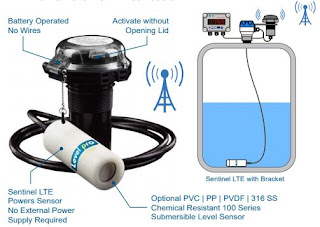Instrumentation is a system of measuring instruments to measure
and record a quantity and quality of various elements. It is an innovation of
modern industries of measurement system and process control of variables within
a production, laboratory, or manufacturing area. An instrument can monitor level,
temperature, flow, distance or pressure. But the level monitoring devices are
one of the best innovation of modern industries. There are various type of
level monitoring going to introduce.
Telemetry tank level sensor is an Instrument which attached
to an impact system may provide level data via wireless signals. These devices
control a desired output variable, and supply either remote or automated
control capabilities. These are often mentioned as final control elements when
controlled remotely or by an impact system. A transmitter may be a device that
produces an output, often within the sort of a 4 20 mA electrical current
signal, although many other options using voltage, frequency, pressure, or
Ethernet are possible.
Instruments are often a part of an impact system in
refineries, factories, and vehicles. The control of processes is one among the
most branches of applied instrumentation. Instrumentation also can ask handheld
devices that measure some desired variable. Diverse handheld instrumentation is
common in laboratories, but are often found within the household also. for
instance, a smoke detector may be a common instrument found in most western
homes.
This signal are often used for informational purposes, or it
are often sent to a PLC, DCS, SCADA system, Lab VIEW or other sort of
computerized controller, where it are often interpreted into readable values
and wont to control other devices and processes within the system. Control
instrumentation plays a big role in both gathering information from the sector
and changing the sector parameters, and intrinsically are a key a part of
control loops.
Process Parameters (also called a process variable) are
certain measures that ask status of the method (their values indicate whether
the method meets the plan or it needs adjustment). so as to get effective
execution of the method its parameters should stay under continuous control.
The simplest samples of parameters you'll find during a
manufacturing process are pressure, temperature, and chemical composition –
anyone of those may have its desired level monitoring system which give data of
point level of tank. While if a Telemetry Chemical Level Sensor deviates from
its set-point (goes beyond the suitable level of variance), then probably a
process tends to fail, hence special automatics or human operators should poke
into this process to regulate it and stop upset.













